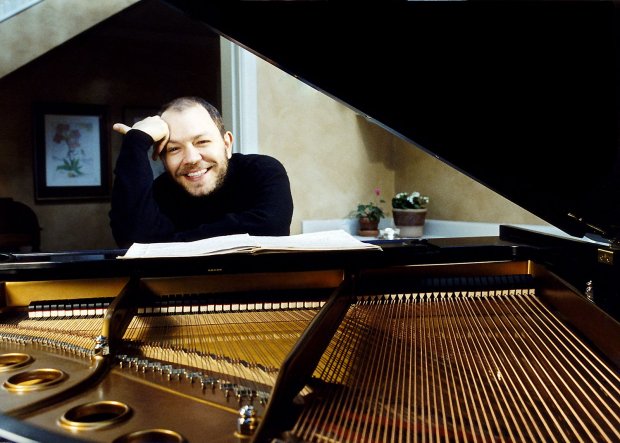The death in March this year of the distinguished Turkish pianist Ayşegül Sarıca, who was trained in Istanbul and Paris, has recently been marked by a performance of Bach's Goldberg Variations by fellow Turkish pianist Özgür Aydın. The concert, subtitled ‘A Day of Respect for Ayşegül Sarıca’, took place on Sunday October 15 at the Cemil Reşit Rey Concert Hall.
Özgür Aydın, born to Turkish parents in Colorado, USA, currently lives in Berlin and teaches at the Universität der Künste (University of the Arts) there. His musical career began at the Ankara State Conservatoire, and thereafter he studied with Peter Katin at the Royal College of Music in London, and with Karl-Heinz Kämmerling at the Hochschule für Musik, Theater und Medien in Hanover. He has also received instruction from such important pianists as Tatiana Nikolayeva (one of my personal favourites), Sir András Schiff and Ferenc Rados.
Mr Aydın’s first public performance of a concerto took place in 1997, when he played Brahms’s Piano Concerto No 1 with the Bavarian Radio Symphony Orchestra. That same year he won the ARD International Music Competition in Munich and the Nippon Music Award in Tokyo. Orchestras with which he has appeared as soloist include the BBC Concert Orchestra, the Simón Bolivar Youth Orchestra of Venezuela, the Slovak State Philharmonic and the Calgary Philharmonic Orchestra. He has also given recitals at such prestigious venues as the Carnegie Hall in New York, the Wigmore Hall in London, the Herkulessaal in Munich and the Suntory Hall in Tokyo.
He delivered his concert's introductory speech with a description of the Goldberg Variations in Turkish, thus demonstrating that his residence in countries outside Turkey has not deprived him of the ability to speak his native language. He then sat down at the piano and began to play the opening theme of the Variations – a tense moment in view of the fact that by doing so he was letting himself in for a marathon that was to last an hour and 18 minutes.
The Goldberg Variations, intended for performance on the harpsichord and first published in 1741, consist of a theme plus 30 variations. They were written while Bach was living in Leipzig ( from 1723 onwards). There he was employed both as Cantor of the Thomasschule at the Thomaskirche and as Director of Music in the town's two principal churches. A Wikipedia entry gives the background to the work’s composition and a blow-by-blow account of each of the various pieces: https://en.wikipedia.org/wiki/Goldberg_Variations
In order to enable the reader to better understand what I mean when I refer to a specific variation, hereafter I will provide time stamps from a YouTube video in which the whole set of 30 is played (by Kimiko Ishizaka). This video has the added advantage of allowing one to follow the score with the aid of a cursor. Here is a link.
My initial reaction to Mr Aydın’s playing, I have to say, was not favourable: when playing the opening theme (at 0:00:00 in the above video) he sounded hesitant, and the melodic line was not always audible. This situation continued throughout the first two variations (0:05:01 and 0:06:57) – where the middle parts sometimes obscured the melodic line, some notes of the melody did not sound at all, and there were occasional splashes. However, given the fact that the Goldberg Variations is such a long work, I had to give the pianist the benefit of the doubt: he was probably saving himself, I thought, for the pyrotechnics that would test his stamina later on.
Things picked up in the third and fourth variations (0:09:04 and 0:11:01), where Mr Aydın seemed to acquire greater confidence. After a brief lapse in Variations 6 and 7 (0:13:44 and 0:15:23), which brought more absent or slightly mis-hit notes and (in the first of these two pieces) a degree of staccato that I thought rather exaggerated, he came into his own in Variation 8 (0:17:35). By this time, perhaps, I had become more accustomed to his light touch on the instrument. At any rate, it seemed to me that by Variation 9 (0:19:32) he had well and truly got into his stride, and I liked the way he brought out the alto part here. From this point on I began to see his playing as delicate rather than over-reticent – especially in Variations 12 and 13 (0:25:34 and 0:27:50) – and I admired the way he managed the trills and ornaments with split-second accuracy in Variation 14 (0:32:04).
Variation 15 (0:34:22) is a lament in the minor key that lends itself to emotional treatment. I thought the pianist over-romanticised here, however. Having been trained by my own teachers to avoid losing the underlying rhythm in Bach’s slow pieces, I have to admit that Mr Aydın gave himself rather more leeway in the time-keeping department than I thought justified. In his defence, though, I would say that there are not many places in the Goldberg Variations where the sun is obscured by clouds, so the performer is understandably tempted to seize such opportunities for displays of moodiness as are offered.
After this variation, which marks the half-way point in the work (0:38:50), the pianist gave himself a short break. With extended running passages to face soon enough, I really couldn’t blame him for taking time out to mop his brow. The Sturm und Drang duly came upon him in Variation 20 (0:47:03), with its fast-paced hand-crossings and helter-skelter running passages, and at this point I gave him full credit for having had the prudence to pace himself earlier on: the pyrotechnics were well managed, with no sign of tiredness or strain.
Mr Aydın’s confident playing in Variation 21 (0:49:09), another venture into the minor key, was excellent, as indeed it was in the following variation (0:53:03), where a guileless melody brings instant relief from the darkness with its insouciance. The Empire strikes back, however, in Variation 25 (0:59:43). Here the depths are well and truly plumbed, each downward shift in the bass line bringing a further descent into the Slough of Despond. (There is a similar step-by-step emotional collapse in the Prelude in E flat minor from Book I of the 48, by the way. Who said Bach was a stone-cold formalist?) Although I wished Mr Aydın had chosen a slower tempo, I appreciated the fact that he did not neglect to squeeze the last drops out of the emotional lemon, especially in the second half of the piece. I noticed that by this time the audience had become totally involved, and were absolutely silent – always a good sign.
The Goldberg Variations ends with a restatement, of the theme (1:19:32). In his introductory speech, Mr Aydın had pointed out that the second time the theme is heard it is endowed with extra meaning, thanks to all that has come before, and this was certainly true at the concert on October 15. In this particular rendition some of that extra meaning was conveyed by rubato, and I personally would have let the music speak for itself here – this pianist does, after all, have a strong line in semplice (with simplicity) playing, as he showed us in Variation 22 (0:53:03). This being said, I very much liked the breathlessly quiet way he played right at the end. It endowed the performance with extra intensity.
To my mind, Özgür Aydın’s approach to the Goldberg Variations was somewhat over-reticent, especially early on. Three things need to be borne in mind, however. Firstly, of course, every performer of proven technical competence and musicality has the right to his or her own interpretation of the piece, and Bach is much more open to different interpretations than most composers. (Indeed, opinions on the subject of how he should ideally be played have varied enormously over the past 150 years.) Secondly, the Variations were written for the harpsichord, an instrument with much less ability to sustain notes – and certainly much less firepower – than the modern piano. And thirdly, Mr Aydın’s delicacy of touch did work, and work well, once one had got used to it.
To illustrate my point about how vastly different interpretations of Bach can be, I will now list some other performers’ renditions of the Variations. First, just in case there is anyone in the known universe who still hasn’t listened to Glenn Gould’s 1955 recording, here it is. It has been said, with some degree of truth, that this music is not Bach, but Gould. But whatever one may say about its authorship, it is undoubtedly a masterpiece.
Now, here are two interpretations by Russian pianists. Tatiana Nikolayeva (1924–93) was the pianist to whom Shostakovich dedicated his own 24 Preludes and Fugues. At one stage, as previously stated, she gave lessons to Özgür Aydın. I have already made known my admiration for this lady, born with a Sun-Moon-Mercury conjunction in the sign of the Bull, all three of these being in square aspect to Neptune. (Any astrologer will tell you that no musician’s birth chart is complete without a nod to Neptune.) I think her Taurean stability and solidity works especially well with Bach. In fact, I recommend the reader to listen to her recordings of his Partitas and French Suites, as well as this one of the Goldberg Variations.
Grigory Sokolov has recorded some of Bach’s Partitas, but not (regrettably) all in the same place. You will have to search for them individually – I advise starting with No 4, which has not one but two gorgeous slow movements. His recordings of the 48 Preludes and Fugues, while marred by blips in the sound quality and (so I am told) the odd lapse of memory, are also worth a visit. Here he is playing the Goldberg Variations with his usual sensitivity and subtlety.
It is high time we returned to the subject of Özgür Aydın, and I will now do so by listing a recording of him playing the justly famous third movement of Beethoven’s Piano Sonata No 17, a work dubbed (though not by the composer himself) the ‘Tempest’. This pianist does Beethoven well, I think – in fact, he has recorded all 32 sonatas and 5 concertos. It is true that Mr Aydın’s tendency to sideline the melody in favour of the inner parts is sometimes apparent here, but the sense of urgency he brings to the piece is entirely in keeping with the composer’s restless spirit.
Anyone who has doubts about Mr Aydın’s technique should listen to his feisty interpretation of Liszt’s Après une lecture de Dante. Any pianist who has not spent the best part of his life working out (in a figurative sense, of course) could not possibly hope to crack this one, I assure you: those rapid-fire octaves towards the end are a killer.
In conclusion, I am grateful for having had the opportunity to acquaint myself with yet another Turkish pianist of obvious talent and ability. So my thanks go to Özgür Aydın for coming to Istanbul to perform Bach’s Goldberg Variations for us.
But that is not quite all – let us remember that this concert was intended as a tribute to another fine Turkish pianist, Ayşegül Sarıca. Here she is in the slow movement of Mozart’s Piano Concerto No 23 (K488) with the Ankara Chamber Orchestra, conducted by Gürer Aykal. Nothing in Mozart, except possibly the two slow movements (the second of which leads into the finale) of his String Quintet No 4 in G minor, K516, brings tears to my eyes as much as this piece does, and here the pianist is playing with maturity and poise. Rest in peace, Ms Sarıca.



_The_Golden_Horn_at_Dusk_c._1900_140_92_80.jpg)



